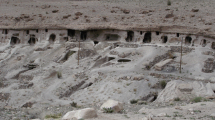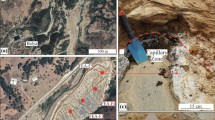Abstract
The magnesium and iron sulfate mineral slavikite has been found in Pastora Mine, Aliseda, Cáceres, Spain, in association with a number of other sulfate minerals such as alunogen, fibroferrite and tschermigite. Remarkably, slavikite is the major phase on some walls of Pastora Mine. To the best of our knowledge, this is the first reported occurrence of slavikite in Spain. Here, we present a mineralogical characterisation of the slavikite found in Pastora Mine using X-ray powder diffraction, scanning electron microscopy, energy-dispersive X-ray spectroscopy, electron probe micro-analysis and thermogravimetry. This characterisation also includes an analysis of the morphology of slavikite crystals based on the Bravais-Friedel-Donnay-Harker method, and the determination of the following slavikite formula from microprobe analyses and thermogravimetric data: Mg4Fe10(SO4)15(OH)8·13(H2O). Finally, we discuss the possible formation conditions of slavikite in Pastora Mine on the basis of available geological information and water analyses. We hypothesise that the presence of slavikite as major sulfate phase in some sites of Pastora Mine is partially the result of a process of mineral enrichment in which the moderate solubility of slavikite and wet and dry weathering cycles play a major role.
Resumen
El mineral eslavikita, sulfato de hierro y magnesio, se ha encontrado en la Mina Pastora, Aliseda, Cáceres, España, asociado con otros sulfatos como alunógeno, fibroferrita y tschermigita. La eslavikita es la fase más abundante en algunas de las paredes de la Mina Pastora. Hasta donde tenemos conocimiento, ésta es la primera vez que se documenta la presencia de eslavikita en España. En este trabajo se presenta la caracterización mineralógica de la eslavikita encontrada en la Mina Pastora utilizando difracción de rayos X por método de polvo, microscopía electrónica de barrido, espectroscopia de rayos X por energía dispersiva, micro sonda electrónica y análisis termogravimétrico. Esta caracterización incluye también un análisis de la morfología de los cristales de eslavikita, utilizando el método Bravais-Fiedel-Donnay–Harker, y la determinación de la fórmula de la eslavikita a partir de los análisis químicos y termogravimétricos: Mg4Fe10(SO4)15(OH)8·13(H2O). Finalmente, se discuten las posibles condiciones de formación de la eslavikita en la Mina Pastora a partir de los datos geológicos disponibles y de los análisis de aguas locales. El hecho de que la eslavikita sea el sulfato más abundante en algunos lugares de la Mina Pastora indica la actuación de procesos de enriquecimiento mineral en los que la moderada solubilidad de la eslavikita y los ciclos de meteorización secos y húmedos juegan un papel importante.






Similar content being viewed by others
References
Bravais, A. (1866). Etudes cristallographiques (p. 290). Paris: Gauthier Villars (in French).
Coombs, P. G., & Munir, Z. A. (1989). The decomposition of iron (III) sufate in air. Journal of Thermal Analysis, 35(3), 967–976.
Coskren, T. D., & Lauf, R. J. (2000). Minerals of Alum Cave Bluff: Great Smoky Mountains, Tennessee. Mineralogical Record, 31, 163–175.
Crespo, A. (2015). La mina Pastora, Aliseda (Cáceres) como exponente del patrimonio geológico-minero de Extremadura. Master Thesis, Universidad Complutense de Madrid, Spain (in Spanish).
Donnay, J. D. H., & Harker, D. (1937). A new law of crystal morphology extending the Law of Bravais. American Mineralogist, 22, 446–467.
Friedel, G. (1907). Etudes sur les lois de Bravais. Bulletin de la Société Francaise de Mineralogie, 30, 326–455 (in French).
Gordon, S. (1941). Slavikite, butlerite, and parabutlerite from Argentina. Notulae Naturae of the Academy of Natural Sciences of Philadelphia, 89, 8.
Hammerschmidt, J. (2009). Decomposition of metal sulfates—A SO2 source for sulfuric acid production. In: Sulphur and Sulphuric Acid Conference 2009. The Southern African Institute of Mining and Metallurgy: Sun City, South Africa, pp. 87–100.
Hazen, R. M., Grew, E. S., Downs, R. T., Golden, J., & Hystad, G. (2015). Mineral ecology: Chance and necessity in the mineral diversity of terrestrial planets. Canadian Mineralogist, 53, 295–324. doi:10.3749/canmin.1400086.
Hubbard, C. R., & Snyder, R. L. (1988). RIR-measurement and use in quantitative XRD. Powder Diffraction, 3(2), 74–77.
Jirkovský, R., & Ulrich, F. (1926). Slavikite, nouveau mineral. Vĕstnik Státni Geologického Ustavu Československé Republiky, 2, 348–351 (in French).
Joeckel, R. M., Wally, K. D., Fischbein, S. A., & Hanson, P. R. (2007). Sulfate mineral paragenesis in pennsylvanian rocks and the occurrence of slavikite in Nebraska. Great Plains Research, 17, 17–33.
Julivert, M., Fontboté, J. M., Ribeiro, A., & Nabais Conde, L. E. (1974). Mapa tectónico de la Península Ibérica y Baleares 1:1.000.000 (p. 113). Madrid: IGME (in Spanish).
Martín, J. D. (2008). Programa para el análisis por difracción de rayos X. Métodos de polvo.
Momma, K., & Izummi, F. (2011). VESTA 3 for three-dimensional visualization of crystal, volumetric and morphology data. Journal of Applied Crystalography, 44, 1272–1276.
Olías, M., Nieto, J. M., Sarmiento, A. M., & Cánovas, C. (2010). La contaminación minera de los ríos Tinto y Odiel (p. 166). Huelva: Universidad de Huelva (in Spanish).
Parafiniuk, J. (1991). Fibroferrite, slavikite and pickeringite from the oxidation zone of pyrite-bearing schists in Wieściszowice (Lower Silesia). Mineralogia Polonica, 22, 3–16.
Parafiniuk, J., Dobrzycki, Ł., & Woźniak, K. (2010). Slavikite-Revision of chemical composition and crystal structure. American Mineralogist, 95, 11–18.
Rost, R. (1941). Die chemische zusammensetzung des slavikits. Mitteilungen der Tschechischen Akademie der Wissenschaften, pp. 1–6 (in German).
Scheidema, M. N., & Taskinen, P. (2011). Decomposition thermodynamics of magnesium sulfate. Industrial and Engineering Chemistry Research, 50(16), 9550–9556.
Siriwardane, R. V., Poston, J. A., Fisher, E. P., Shen, M. S., & Miltz, A. L. (1999). Decomposition of the sulfates of copper, iron (II), iron (III), nickel, and zinc: XPS, SEM, DRIFTS, XRD, and TGA study. Applied Surface Science, 152(3–4), 219–236.
Smykatz-Kloss, W., & Warne, S. S. J. (1991). Thermal analysis in geoscience. Lecture notes in Earth sciences 38 (p. 367). Berlin: Springer.
Soldevila i Batolí, J. (1991). Estudio geológico-estructural de los materiales precámbricos y paleozoicos entre la Sierra de San Pedro y la Depresión del Guadiana (provincias de Cáceres y Badajoz). Sector límite entre las zonas Centroibérica y Ossa-Morena. Ph. D. Thesis, Universidad Autónoma de Barcelona, Barcelona, p. 262 (in Spanish).
Soldevila i Batolí, J. (1992). La sucesión paleozoica en el Sinforme de la Sierra de San Pedro (provincias de Cáceres y Badajoz, SO de España). Estudios Geológicos, 48, 363–379 (in Spanish).
Süsse, P. (1975). Struktur und Kristallchemie des Slavikits, NaMg2Fe5(SO4)7(OH)6·33H2O. Neues Jahrbuch fur Mineralogie, Monatshefte, 1975, 27–40. (in German).
Van Tassel, R. (1972). Slavikite—a review. Acta Musei Nationalis Pragae, 27B, 1–14.
Acknowledgements
This work was supported by the Spanish Government (MAT2012-38810 and CGL2013-48247-P). AFM and SEM images, and EDX analyses were obtained at the ICTS Centro Nacional de Microscopia Electrónica (UCM). ICP-OES Chemical analyses of AMD waters and slavikite solutions were conducted at CAI of Técnicas Geológicas (UCM). Authors would like to thank Belén Soutullo for collecting X-ray diffractograms. Carlos Pimentel is grateful to the Spanish Government for a FPU Fellowship. Ángel Crespo sincerely thanks José Ángel López and Roberto Oyarzun for initiating him into the research in Mineralogy. This paper has been greatly benefited from supplementary data and discussion with Adolf Cortel.
Author information
Authors and Affiliations
Corresponding author
Electronic supplementary material
Below is the link to the electronic supplementary material.
Rights and permissions
About this article
Cite this article
Crespo López, Á., Pimentel, C., Pedraz, P. et al. First occurrence of the rare mineral slavikite in Spain. J Iber Geol 43, 487–495 (2017). https://doi.org/10.1007/s41513-017-0030-6
Received:
Accepted:
Published:
Issue Date:
DOI: https://doi.org/10.1007/s41513-017-0030-6




